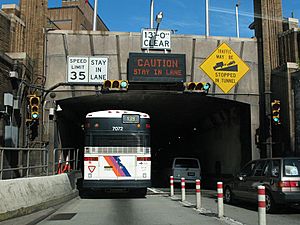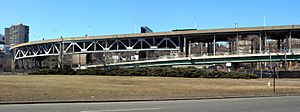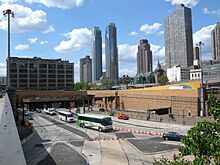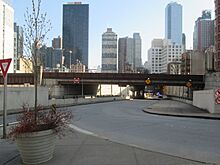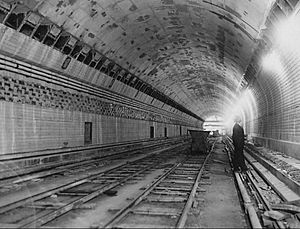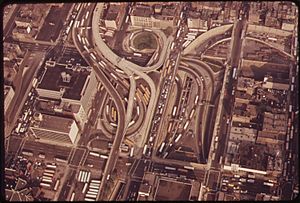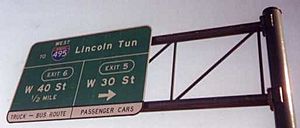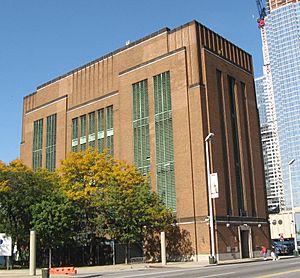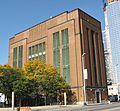Lincoln Tunnel facts for kids
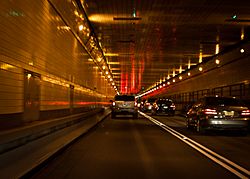 |
|
| Inside the tunnel, February 2011 | |
| Overview | |
|---|---|
| Location | Weehawken, New Jersey, to Midtown Manhattan, New York City |
| Coordinates | 40°45′45″N 74°00′40″W / 40.7625°N 74.0111°W |
| Status | Open |
| Route | |
| Start | Weehawken, New Jersey |
| End | New York, New York |
| Operation | |
| Owner | Port Authority of New York and New Jersey |
| Operator | Port Authority of New York and New Jersey |
| Traffic | Automotive |
| Toll | (Eastbound only) As of August 29, 2019:
|
| Vehicles per day | 112,995 (2016) |
| Technical | |
| Construction | March 1934 – December 1937 (center tube) 1937–1938, 1941–1945 (north tube) 1954–1957 (south tube) |
| Length | 7,482 ft (2,281 m) (north) 8,216 ft (2,504 m) (center) 8,006 ft (2,440 m) (south) |
| Number of lanes | 6 |
| Operating speed | 35 miles per hour (56 km/h) |
| Lowest elevation | −97 feet (−30 m) |
| Tunnel clearance | 13 feet (4.0 m) |
| Width | 21.5 feet (6.6 m) |
The Lincoln Tunnel is a long tunnel under the Hudson River. It connects Weehawken, New Jersey, with Midtown Manhattan in New York City. The tunnel is about 1.5 miles (2.4 km) long. It helps cars travel between New Jersey and New York.
The tunnel is named after Abraham Lincoln, a famous U.S. President. It has three separate tubes for vehicles. Each tube has two lanes for traffic. The middle tube can change direction to help with busy traffic. The other two tubes are for traffic going only one way.
Building the Lincoln Tunnel happened in stages. The first tube opened in 1937. The second tube opened in 1945. The third tube opened in 1957. The Port Authority of New York and New Jersey owns and operates the tunnel. It is one of several crossings they manage in the New York area.
The Lincoln Tunnel is one of two car tunnels under the Hudson River. The other is the Holland Tunnel. In 2016, about 112,995 vehicles used the Lincoln Tunnel every day. Drivers pay a toll when they go from New Jersey to New York.
Contents
What are the Lincoln Tunnel's tubes like?
The Lincoln Tunnel has three tubes. Together, they have six lanes for cars. In 2016, over 112,000 vehicles used the tunnel daily. In 2017, nearly 20 million tolls were collected for eastbound traffic.
The middle tube is special because its lanes can change direction. This helps handle more cars during busy times. The north tube is only for cars going west to New Jersey. The south tube is only for cars going east to New York. Usually, only cars use the tunnel. But sometimes, special events like bike tours or races happen there.
Each tube is 21.5 feet (6.6 m) wide. It has a height limit of 13 feet (4.0 m). Most vehicles carrying dangerous materials are not allowed. Trucks cannot use the center tube. Vehicles wider than 8 feet 6 inches (2.59 m) cannot enter.
The three tubes start close together in New Jersey. But in New York City, they come out in different spots. The north tube's exit is near Eleventh Avenue. The center and south tubes exit together at Tenth Avenue. This makes the tubes different lengths. The center tube is the longest at 8,216 feet (2,504 m). The south tube is 8,006 feet (2,440 m) long. The north tube is 7,482 feet (2,281 m) long.
The Port Authority has special teams for emergencies. They have fire trucks, rescue trucks, and tow trucks. Cameras also watch the tunnel to keep traffic moving safely.
How do cars get to the tunnel in New Jersey?
The main road to the tunnel on the New Jersey side is New Jersey Route 495. This road goes through Union City, New Jersey. It is built in an open cut, like a trench.
The New Jersey approach road is called "the Helix." It used to be called "the Corkscrew." This road makes a big curve, like three-quarters of a circle. It does this to get down to the tunnel entrance. This is because of a steep cliff called King's Bluff in Weehawken. The Helix road is about 4,000 feet (1,200 m) long.
Route 495 comes from the west and crosses over John F. Kennedy Boulevard East. Then, the road curves south and goes downhill. There are ramps for cars to exit to other streets. The road goes onto a rock shelf and then a bridge. This bridge goes down, then turns west, then north.
As the road turns, it crosses JFK Boulevard East again. Park Avenue runs next to the road. Ramps connect Park Avenue to the tunnel. The road eventually reaches the tunnel entrances. There is a toll plaza with 13 lanes for collecting tolls.
In 2015, the Port Authority thought the Helix would last only ten more years. In 2018, the New Jersey Department of Transportation started fixing the Helix. This project will take over two years. The Helix is known for having a lot of traffic jams. Drivers spend millions of hours stuck in traffic there each year.
An administration building is also located on the New Jersey side. It is along Boulevard East.
How do cars get to the tunnel in Manhattan?
When cars leave the Lincoln Tunnel in Manhattan, they usually use Dyer Avenue. This road also leads directly to the Port Authority Bus Terminal. Another option is the Lincoln Tunnel Expressway. This highway goes below street level.
Dyer Avenue is between Ninth and Tenth Avenues. It has three separate parts. The Lincoln Tunnel Expressway connects the south part of Dyer Avenue to the tunnel. Galvin Avenue is another main road to the tunnel. It runs between Tenth and Eleventh Avenues. It carries southbound traffic from 41st to 40th Streets.
The southernmost tube brings eastbound traffic to New York. It comes out near 38th Street and Tenth Avenue. It leads to both parts of Dyer Avenue. The northern part goes to 40th to 42nd Streets. It is for northbound traffic. The southern part goes to 34th to 36th Streets. It carries traffic in both directions. At 36th Street, an exit ramp leads to the Lincoln Tunnel Expressway. This expressway continues to 31st and 30th Streets.
The center tube can change direction. It comes out near 39th Street and Tenth Avenue. It connects to the southbound Lincoln Tunnel Expressway. An exit ramp also leads to Dyer Avenue. A ramp from the northbound expressway also goes to the center tube.
The northern tube carries westbound traffic to New Jersey. It is fed by four ramps. One ramp starts at 30th Street and Dyer Avenue. It leads to the northbound Lincoln Tunnel Expressway. Another ramp comes from 33rd Street. A third ramp comes from Dyer Avenue between 34th and 36th Streets. This ramp connects to the expressway. The expressway then goes into a short tunnel. The fourth ramp merges with traffic from 40th Street and Galvin Avenue. After this, the road goes into the northern tube near Eleventh Avenue.
What is the Exclusive Bus Lane?
During the morning rush hour, one lane in the center tube is only for buses. This is called the Lincoln Tunnel Exclusive Bus Lane (XBL). Buses from the New Jersey Turnpike and New Jersey Route 3 use it.
The XBL is the busiest bus lane in the United States. It runs on weekday mornings from 6:00 to 10:00 a.m. About 1,850 buses and 70,000 people use it. Most of these people go to the Port Authority Bus Terminal. More people ride buses using the XBL than ride NJ Transit trains into Penn Station. Over 100 bus companies use this special lane.
The XBL was first thought of in 1964. It was tested in September 1970. This was because buses from New Jersey were getting stuck in traffic. The bus lane started in December 1970. It was so successful that it became a permanent feature. The XBL was stopped for a short time in 2020 due to the COVID-19 pandemic. It started again in September 2020.
How was the Lincoln Tunnel built?
Planning the tunnel
The idea for a three-tube tunnel under the Hudson River came up in 1923. It would connect Weehawken, New Jersey, to Manhattan. The first car tunnel under the Hudson, the Holland Tunnel, opened in 1927. It was very popular. This led to more ideas for new tunnels.
In 1928, New York and New Jersey governors supported new transportation links. They wanted a tunnel from Weehawken to Manhattan. This tunnel would help traffic in Midtown Manhattan. It was also hoped to connect New Jersey to Long Island.
By 1930, New York and New Jersey agreed to build the tunnel. But they disagreed on who would pay for it. The Port Authority and the states' tunnel commissions both wanted to build it. They also had different ideas about how much it would cost. The Wall Street Crash of 1929 made it harder to find money.
In April 1930, the tunnel commissions joined with the Port of New York Authority. The new Port Authority would build and run the tunnel. In June 1930, it was named the "Midtown Hudson Tunnel." They started studying traffic patterns. By 1931, the Port Authority decided the tunnel was possible. They wanted to start building right away.
The start of construction was delayed by the Great Depression. The Port Authority could not get enough money. In August 1933, the Public Works Administration (PWA) gave a loan of $37.5 million. This was enough to build one tube. The Port Authority accepted the loan.
Plans for the New Jersey side were made in September 1933. The New York side would come out near 39th Street. The United States Department of War approved the tunnel in October 1933. They made sure it would be deep enough for ships.
Building the first tube
In November 1933, the Port Authority chose the engineers for the tunnel. Construction of the first tube began on May 18, 1934. There were ceremonies on both sides of the river. New York City Mayor Fiorello H. La Guardia helped dig the first dirt.
A large caisson (a watertight box) was sunk into the riverbed in July. This helped workers dig the tunnel. There were some problems, like Weehawken not allowing blasting for more than 12 hours a day. Also, union workers worried about unskilled laborers taking their jobs. These issues were resolved.
The Port Authority also had to buy and clear land for the tunnel's roads. In New York, 91 buildings were torn down. In New Jersey, there was a debate about how to build the road because of King's Bluff. In July 1935, Weehawken approved a special "loop" approach.
Special construction workers called Sandhogs dug the tunnel from both ends. They used compressed air to keep water out. It was easier to dig from the New Jersey side because the ground was softer. The two ends of the tube met in August 1935, ahead of schedule.
The tunnel was then prepared for cars. Workers installed ceiling panels, a roadway, and ceramic tiles. They also put in fireproof copper sheeting. By October 1937, most of the work was done. The tunnel was set to open in late 1937.
In April 1937, the tunnel was renamed the "Lincoln Tunnel." This was to avoid confusion with the Queens–Midtown Tunnel. It was also to show its importance, like the George Washington Bridge. Two roads on the Manhattan side were named after important Port Authority chairmen: Galvin Avenue and Dyer Avenue.
Opening and early years

The first tube opened on December 22, 1937. There was a military parade and speeches. The first cars drove through at 4:00 AM. A sculptor made a special medal for the opening.
The new tube carried traffic in both directions. Cars paid 50 cents. Trucks and motorcycles paid different tolls. People walking, animals, and bikes were not allowed. Heavy trucks were temporarily banned. A minimum speed limit of 20 mph (32 km/h) was set.
The tunnel was used by 7,661 vehicles on its first day. The Port Authority advertised it as "the Direct Way to Times Square." Traffic was lower than the Holland Tunnel at first. The Port Authority used slogans to encourage drivers to use it. By 1942, 4.5 million vehicles used the tunnel each year.
Bus companies started using the tunnel in 1938. Before this, buses used ferries. By 1939, 600 buses used the tunnel daily. In 1940, plans for a new bus terminal in Manhattan were announced. This terminal would connect directly to the tunnel. However, these plans were delayed by World War II.
Building the second tube
In November 1936, the Port Authority decided to build a second tube. It would be north of the first tube. The second tube was expected to cost $33 million. Funds were secured in 1937. The second tube was planned to be finished by 1940.
Construction on the second tube started. A steel caisson was sunk in Manhattan in July 1937. Land was bought in New Jersey for the new tube. The "express highway" in New Jersey was also part of this project. This highway would connect to other major roads.

The two parts of the second tube were connected in May 1938. This was impressive because traffic was still using the first tube nearby. However, work stopped because New Jersey did not have enough roads ready. Also, there were economic concerns.
Work on the second tube started again in April 1941. The United States Army said the tunnel was important for the war. So, the Port Authority sped up plans. New roads were built in Manhattan and New Jersey. But wartime shortages caused more delays. Work picked up again in late 1943.
How did two tubes operate?
The second tube opened on February 1, 1945. It was north of the first tube. The new north tube carried westbound traffic to New Jersey. The original tube became eastbound-only to New York. The two tunnels together cost $80 million. There was no big ceremony for this opening.
After World War II, plans for the new bus terminal in Manhattan were restarted. It would have a parking lot on its roof. The terminal opened in 1950 as the Port Authority Bus Terminal.
Building the third tube
The Port Authority started planning a third tube in the early 1950s. This was because the first two tubes were getting very busy. They ordered steel for the tube in October 1952. They also had to move 900 families from 70 buildings to make space.
Weehawken's government was not happy about the new tunnel work. They tried to stop it in June 1953. But a judge allowed the work to continue. The Supreme Court of New Jersey also tried to stop it in 1954. However, the New Jersey legislature voted to let the work continue.
Construction of a ventilation building in New York began in June 1954. The New Jersey tunnel plaza was also rebuilt. A new parking lot opened in November 1955.
Sandhogs began digging the tunnel from New Jersey. They planned to meet the digging from New York. The digging shield started working in late 1954. In February 1955, contracts were given to widen the New Jersey approach roads.
Work on the tube stopped briefly in January 1956 due to a water leak. Workers also went on strike. On June 28, 1956, the two sides of the tunnel finally met. The last of the tunnel's iron rings were put in place.
The third tube opened on May 25, 1957. It was south of the other two tunnels. It cost $94 million. No workers were killed during its construction. This was different from the first two tubes. The Lincoln Tunnel became the world's first tunnel with three parallel tubes.
After the third tube opened, the center tube went back to being two-way. But it could still be used for one-way traffic during busy times. A new toll plaza with 18 booths was opened. It collected tolls from the driver's side. This was expected to make traffic faster.
What improvements have been made over the years?
As more cars used the tunnel, the Port Authority found ways to reduce traffic jams. In 1957, they started training "spotters" to watch traffic. In 1958, they used two-way radios. From 1966 to 1967, they installed cameras to watch traffic. Port Authority officers watched from a control center in New Jersey.
In December 1970, the special bus lane was tested. It was so popular that it became permanent. In 1971, the elephants from the Ringling Bros. and Barnum & Bailey Circus walked through the tunnel. They stopped doing this in 2016 when the elephants retired.
The original brick roads in the north and center tubes wore out. They were repaved with asphalt in 1967–1968. By 1971, 32 million vehicles used the tunnel each year. Until 1970, the toll was 50 cents in both directions. In 1970, westbound tolls were removed. Eastbound tolls doubled to $1.00.
In the 1980s, the center tube was repaved. This was to prepare for work on the Holland Tunnel. After that, the north and south tubes were repaved. In 1989, a computer system was added to control traffic. This system used 73 cameras. Cellphone service was added to the tubes in 1995.
A big renovation of the center tube started in 1996. It cost $53 million. This included replacing tiles and other parts. The toll plaza was also renovated for $42 million. After the September 11 attacks in 2001, some traffic rules changed temporarily.
How are the Lincoln Tunnel's routes numbered?
|
|
|
|---|---|
| Location: | Manhattan |
| Length: | 1.09 mi (1.75 km) |
The Lincoln Tunnel was once planned to connect to the Queens-Midtown Tunnel. This would have been through a highway across Manhattan. This highway was called the Mid-Manhattan Expressway. The idea for this highway came up in 1936.
The Mid-Manhattan Expressway project was eventually canceled. The Interstate 495 (I-495) number was removed from the expressway in 1970. However, the I-495 number stayed in New Jersey for a while. Most of the New Jersey I-495 became Route 495 in 1979. The last part of I-495 in New Jersey was removed in 1986. So, the Lincoln Tunnel is no longer part of the Interstate system.
Today, the part of the tunnel in New Jersey is Route 495. It is debated if the New York part of the tunnel is officially New York State Route 495 (NY 495). Some documents say it is 1.09 miles (1.75 km) long. Other documents do not list the tunnel as part of NY 495. They say NY 495 is part of the Long Island Expressway in Queens.
How do tolls work at the Lincoln Tunnel?
As of January 2024, the toll to go from New Jersey to New York City is $17.63 for cars. There is no toll for cars going from New York City to New Jersey. If you use E-ZPass from New Jersey or New York, the toll is lower. It is $13.38 during off-peak hours and $15.38 during peak hours.
Tolls are collected when drivers pass under special toll cameras in Manhattan. Before 1970, tolls were collected in both directions. In August 1970, the westbound toll was removed. The eastbound toll doubled to 1.00. The westbound toll booths were later taken away.
Electronic tolling started around 1988 for buses. In 1996, the Port Authority decided to upgrade the toll plaza for E-ZPass. E-ZPass toll collection began in October 1997.
Open road tolling started on December 11, 2022. This means there are no more toll booths. Drivers cannot pay cash. Instead, cameras read license plates. A bill is mailed to the car owner if they don't have E-ZPass. E-ZPass users are charged automatically. All-electronic tolling was used temporarily during the COVID-19 pandemic. The Lincoln Tunnel was the last Port Authority crossing to accept cash.
Past toll prices
| Years | Toll | Toll equivalent in 2022 |
Direction collected | Ref. |
|---|---|---|---|---|
| 1937–1970 | $0.50 | $10.18–3.77 | each direction | |
| 1970–1975 | $1.00 | $7.54–5.44 | eastbound only | |
| 1975–1983 | $1.50 | $8.16–5.33 | eastbound only | |
| 1983–1987 | $2.00 | $7.10–5.15 | eastbound only | |
| 1987–1991 | $3.00 | $7.73–6.45 | eastbound only | |
| 1991–2001 | $4.00 | $8.59–6.61 | eastbound only | |
| 2001–2008 | $6.00 | $9.92–8.16 | eastbound only | |
| 2008–2011 | $8.00 | $10.87–10.41 | eastbound only | |
| 2011–2012 | $12.00 | $15.61–15.30 | eastbound only | |
| 2012–2014 | $13.00 | $16.57–16.07 | eastbound only | |
| 2014–2015 | $14.00 | $17.31–17.28 | eastbound only | |
| 2015–2020 | $15.00 | $18.52–16.96 | eastbound only | |
| 2020–2023 | $16.00 | $18.09–$16.00 | eastbound only | |
| 2023–2024 | $17.00 | $17.00 | eastbound only | |
| Since January 7, 2024 | $17.63 | $17.63 | eastbound only |
What is the congestion toll?
New York City is planning to charge an extra toll for driving into certain busy areas of Manhattan. This is called congestion pricing. If this plan starts, drivers using the Lincoln Tunnel to enter Manhattan would pay a second toll.
These charges would be collected using E-ZPass or by mail. The cost would change based on the time of day and vehicle type. Drivers who use the Lincoln Tunnel would get a discount on this congestion charge.
Images for kids
See also
 In Spanish: Túnel Lincoln para niños
In Spanish: Túnel Lincoln para niños


